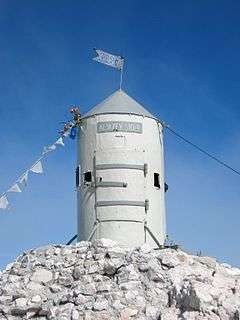Aljaž Tower
| Aljaž Tower | |
|---|---|
| Aljažev stolp | |
 Aljaž Tower. Two inscriptions are visible: Aljažev stolp on the tower, and 1895, the year of construction, on the flag | |
| General information | |
| Type | storm shelter |
| Location | Mount Triglav summit |
| Coordinates | 46°22′42″N 13°50′11″E / 46.37833°N 13.83639°ECoordinates: 46°22′42″N 13°50′11″E / 46.37833°N 13.83639°E |
| Construction started | Early 1895 |
| Completed | 7 August 1895 |
| Inaugurated | 22 August 1895 |
| Owner | Slovenian government |
| Landlord | Ljubljana Matica Alpine Club (unofficially) |
| Height | 1.90 metres (6.2 ft)[1] |
| Dimensions | |
| Diameter | 1.25 m (4.1 ft)[1] |
| Technical details | |
| Structural system | additionally guyed tower |
| Design and construction | |
| Structural engineer | Jakob Aljaž |
| Civil engineer | Anton Belec |
Aljaž Tower (Slovene: Aljažev stolp) or the Triglav Tower (Triglavski stolp) is a tower, a storm shelter and a triangulation point on the summit of Mount Triglav in northwestern Slovenia.[1] Along with Triglav, it is a landmark of Slovenia and a solemn symbol of the Slovenehood. The tower was designed by Jakob Aljaž, a priest in the Upper Carniolan village of Dovje, who also had it erected. Today it is owned by the state, tended by the Ljubljana Matica Alpine Club and stands on a parcel belonging to the Municipality of Bohinj.[2]
History
In the early 1895, hoping to be able to restrain the increased interest of foreigners in the Slovene mountains, Aljaž drew up with a chalk on the floor of his room in the Parish of Dovje plans for a solemn cylindrical tower with a flag on its top.[3] In April that year, he purchased the summit of Triglav for the sum of one Austro-Hungarian gulden from the then Municipality of Dovje. Having done so, he secured himself the right to erect a building on his own real property.[4] The tower was constructed from iron and zinc-coated sheet steel by Anton Belec from Šentvid near Ljubljana. He and four workers brought the parts of the tower to the summit of Triglav and put the tower together in only five hours on 7 August 1895. Its solemn opening and blessing took place in a small circle on 22 August that year.[5]
Aljaž donated the shelter to the Slovene Mountaineering Society.[6] In the beginning, there were three four-legged chairs, a summit register, a spirit stove, and the image The Triglav Panorama by Marko Pernhart in the tower.[1] It was later repainted and renovated several times by Alojz Knafelc and others. In the communist era, as the highest point of the former Yugoslavia, it was painted red and decorated with a red star.[7] However, it has more or less retained its original appearance.[2] The star was removed shortly before the dissolution of Yugoslavia.[7] On the proclamation of Slovene independence in June 1991, the flag of Slovenia was solemnly raised at the tower.[2] On 5 October 1999, the tower and its immediate surroundings were proclaimed a site of national cultural importance for Slovenia.[8]
Gallery
 Summit view with the Aljaž Tower
Summit view with the Aljaž Tower Inside the Aljaž Tower, showing its view orientation map
Inside the Aljaž Tower, showing its view orientation map
References
- 1 2 3 4 Cvirn, Janez (2000). Vidic, Marko, ed. Ilustrirana zgodovina Slovencev. Mladinska knjiga. p. 271. ISBN 86-11-15664-1.
- 1 2 3 Belimezov, Maja (2007-07-25). "Stolp ima 110 let" (in Slovenian). Gore-ljudje.net. Retrieved 2008-09-12.
- ↑ "Ali ste vedeli ..." [Did You Know...]. Slovene Mountaineering Museum. Retrieved 27 May 2014.
- ↑ Mikša, Peter. "Narodnostni boji v planinstvu na Slovenskem do 1. svetovne vojne" [National Battles in Mountaineering in the Slovene Lands Until World War I] (in Slovenian): 65–68. ISSN 1318-2498.
- ↑ Mikša, Peter (January 2015). "Aljažev stolp in Jakob Aljaž – najvišji posestnik" [Aljaž Tower and Jakob Aljaž – the Highest Landowner]. SLO: časi, kraji, ljudje: slovenski zgodovinski magazin (in Slovenian): 30–35. ISSN 2350-4641. COBISS 56812898.
- ↑ "Aljažev stolp vrh Triglava" (in Slovenian). Ljubljana Matica Alpine club. Archived from the original on 2007-12-27. Retrieved 13 November 2007.
- 1 2 Bartolj, Jaka (17 December 2013). "Jakob Aljaž built a tower that has become a Slovenian symbol". MMC RTV Slovenija. RTV Slovenija.
- ↑ "Odlok o razglasitvi Aljaževega stolpa na Triglavu za kulturni spomenik državnega pomena". Official Gazette of the Republic of Slovenia (in Slovenian). Government of the Republic of Slovenia. 1999-10-05. Retrieved 2008-09-13.
External links
- Picture/panorama Peak of Triglav. Virtual panorama.
-
 Media related to Aljaž Tower at Wikimedia Commons
Media related to Aljaž Tower at Wikimedia Commons